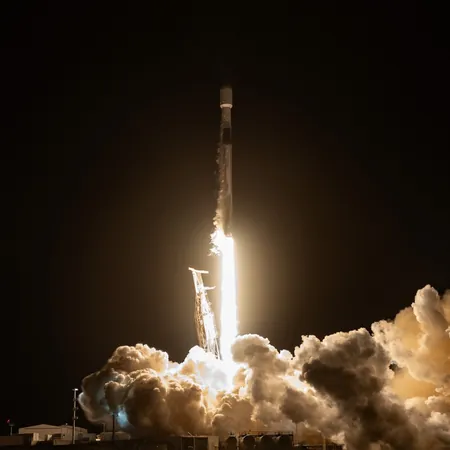
SpaceX Successfully Launches 30 Satellites in Groundbreaking Mid-Inclination Mission
2024-12-21
Author: Sophie
Introduction
In a remarkable display of innovation and determination, SpaceX successfully executed its second mid-inclination rideshare mission, launching 30 satellites into orbit on December 21. This launch, part of the Bandwagon-2 mission, took place at the Vandenberg Space Force Base in California at 6:34 a.m. Eastern Time, using the formidable Falcon 9 rocket.
Launch Details
The first stage of the Falcon 9 rocket, which has been reused for the 21st time, accomplished a flawless landing back at the launch site just 8 minutes and 15 seconds after liftoff, coinciding perfectly with the completion of its second stage burn.
Payloads and Collaborations
While SpaceX initially withheld details regarding the deployment of the 30 payloads, multiple customers reported confirmations of satellite communications shortly after launch, signifying the successful placement of their technologies in orbit.
Among the notable payloads on the Falcon 9 was the third "425 Project" recon satellite developed for the South Korean military, further strengthening the nation's surveillance capabilities. The drive toward advanced reconnaissance began last December with the launch of the first satellite, followed by the second during April's Bandwagon-1 mission.
This mission also hosted satellites from HawkEye 360, including three from their Cluster 11 project, aimed at enhancing radio-frequency intelligence capabilities. The new satellites feature advanced payloads designed to optimize data collection and improve transmission back to ground stations.
In another exciting development, Finnish company Iceye launched two synthetic aperture radar (SAR) satellites capable of delivering high-resolution radar imagery at 25-centimeter accuracy. With a total of 40 satellites now orbiting Earth, Iceye continues to be an essential player in the expanding field of earth observation.
The Bandwagon-2 mission also included contributions from Sidus Space, Tomorrow.io, True Anomaly, and Think Orbital, among others. Exolaunch, a rideshare aggregator, reportedly facilitated 22 of the payloads launched, demonstrating the growing collaborative ecosystem surrounding satellite deployments.
Future Plans
SpaceX's introduction of the Bandwagon line of missions in 2023 aims to complement its well-established Transporter series, specifically catering to the increasing demand for mid-inclination orbits—followed closely in popularity after the sun-synchronous orbit preferences announced previously.
Looking toward the future, SpaceX plans to conduct two more Bandwagon missions in 2024 and another two in 2025, with potential expansions beyond that timeline left open.
Launch Statistics and Goals
As 2023 draws to a close, SpaceX also showcased its ambitious launch schedule, with 130 Falcon launches achieved this year compared to 96 in the previous year. However, they are expected to fall short of their ambitious target of 148 launches, with estimates for 2023 hovering around 136. SpaceX President Gwynne Shotwell acknowledged prior to the mission that the original goal was set at 144, but adjustments were made to incorporate uncompleted launches from the previous year.
Conclusion
With the successful execution of the Bandwagon-2 mission, SpaceX not only solidifies its position as a leader in satellite deployment but also paves the way for a future brimming with advanced technological innovations in space exploration. Keep an eye on SpaceX as they continue to redefine the boundaries of space travel!









 Brasil (PT)
Brasil (PT)
 Canada (EN)
Canada (EN)
 Chile (ES)
Chile (ES)
 España (ES)
España (ES)
 France (FR)
France (FR)
 Hong Kong (EN)
Hong Kong (EN)
 Italia (IT)
Italia (IT)
 日本 (JA)
日本 (JA)
 Magyarország (HU)
Magyarország (HU)
 Norge (NO)
Norge (NO)
 Polska (PL)
Polska (PL)
 Schweiz (DE)
Schweiz (DE)
 Singapore (EN)
Singapore (EN)
 Sverige (SV)
Sverige (SV)
 Suomi (FI)
Suomi (FI)
 Türkiye (TR)
Türkiye (TR)